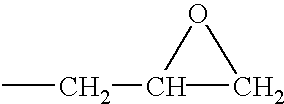Process for the production of molded particles for microbial cell-immobilization
- Summary
- Abstract
- Description
- Claims
- Application Information
AI Technical Summary
Benefits of technology
Problems solved by technology
Method used
Image
Examples
production example 1
[0070] A four-necked flask was fed with 3,000 parts of toluene, 142 parts of glycidylmethacrylate and 0.1 part of hydroquinone, which were stirred. To the resultant mixture, 75 parts of N-methylethanol amine was added dropwise with aeration over a period of one hour at a temperature of 110.degree. C. Said temperature was kept for eight hours for reaction and, thus, a solution of amine-containing diol was obtained. To this solution, 2,000 parts of polyethylene glycol (average molecular weight: about 1,000) and 888 parts of isophorone diisocyanate were added and stirred with further aeration, and, then, the resulting mixture was maintained at 100.degree. C. for eight hours for reaction, and, thus, an isocyanate group-containing urethane resin was obtained. Furthermore, 232 parts of 2-hydroxyethyl acrylate was introduced into reactor, and the resultant mixture was allowed to react at 80.degree. C. for three hours with aeration. After it was confirmed that almost no isocyanate group rem...
production example 2
[0071] A four-necked flask was fed with 1,800 parts of toluene, 520 parts of DENACOL EX-830 (diglycidylether compound manufactured by Nagase Chemtex Corporation), to which, with stirring, 258 parts of dibutylamine was added dropwise over a period of one hour at a temperature of 110.degree. C. Said temperature was kept for eight hours for reaction, and, thus, a solution of amine-containing diol was obtained To this solution, 1,200 parts of polyethylene glycol (average molecular weight: about 600) and 348 parts of 2,4-tolylene diisocyanate were added and stirred, and, then, the resulting mixture was maintained at 100.degree. C. for eight hours for reaction, and, thus, a hydroxyl group-containing urethane resin was obtained Furthermore, 310 parts of ethylmethacrylate isocyanate and 2 parts of hydroquinone were introduced into reactor, and the resultant mixture was allowed to react at 80.degree. C. for three hours with aeration. After it was confirmed that almost no isocyanate group rem...
production example 3
[0072] A four-necked flask was fed with 1,000 parts of toluene, 1,215 parts of DENACOL EX-145 (monoglycidyl compound manufactured by Nagase Chemtex Corporation), to which, with stirring, 225 parts of N-methylethanol amine was added dropwise over a period of one hour at a temperature of 110.degree. C. Said temperature was kept for eight hours for reaction, and, thus, a solution of amine-containing diol was obtained To this solution, 888 parts of isophorone diisocyanate was added and stirred, and, then, the resulting mixture was maintained at 100.degree. C. for eight hours for reaction, and, thus, an isocyanate group-containing urethane resin was obtained. Furthermore, 232 parts of 2-hydroxyethyl acrylate and 2 parts of hydroquinone were introduced into reactor, and the resultant mixture was allowed to react at 80.degree. C. for three hours with aeration. After it was confirmed that almost no isocyanate group remained, 3,900 parts of deionized water was added, and, then, pressure in t...
PUM
| Property | Measurement | Unit |
|---|---|---|
| Percent by mass | aaaaa | aaaaa |
| Percent by mass | aaaaa | aaaaa |
| Percent by mass | aaaaa | aaaaa |
Abstract
Description
Claims
Application Information
 Login to View More
Login to View More - R&D
- Intellectual Property
- Life Sciences
- Materials
- Tech Scout
- Unparalleled Data Quality
- Higher Quality Content
- 60% Fewer Hallucinations
Browse by: Latest US Patents, China's latest patents, Technical Efficacy Thesaurus, Application Domain, Technology Topic, Popular Technical Reports.
© 2025 PatSnap. All rights reserved.Legal|Privacy policy|Modern Slavery Act Transparency Statement|Sitemap|About US| Contact US: help@patsnap.com

